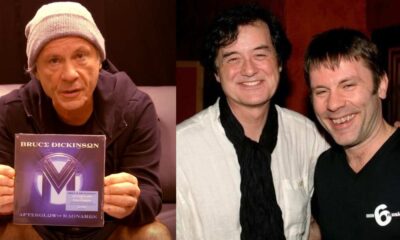ARTICLES
20 essential AC/DC songs to honor Malcolm Young’s memory
Legendary AC/DC guitarist Malcolm Young unfortunately left us with only 64 years old, after a month his oldest brother George Young died. He was not only the founder of the biggest hard rock band of all time, he was an essential piece on the hit machine that AC/DC was.
In order to honor his succesful and brilliant career, we bring you 20 essential AC/DC songs to honor Malcolm Young’s memory.
Check it out:

“High Voltage” by AC/DC
Single (1975)
This song is an early AC/DC track, that plays off their band name, keeping with the electricity theme as Bon Scott sings about their “high voltage rock and roll.” The band would produce many more songs about rock and roll over the next four decades, and these tracks were often the showstoppers at their concerts.
AC/DC’s first album, released in 1975 only in Australia, was called High Voltage, but this song wasn’t part of it. “High Voltage” the song was released as a standalone single, reaching #6 in Australia and goosing sales of the album.
Another Australia-only album (T.N.T.) followed later that year, and in 1976 tracks from these first two albums were compiled, along with this song, for another album called High Voltage that was given international release and set the stage for the band’s rise to stardom. The “High Voltage” single was also released internationally in 1976, and a video was made to promote the song.

“It’s a Long Way to the Top (If You Wanna Rock ‘n’ Roll)” by AC/DC
T.N.T./High Voltage (1975)
This is an autobiographical song for AC/DC describing their struggles as they try to make it big by delivering a top notch live show night after night. It was genuine: at the time they were just getting started and playing some seedy venues with even seedier business associates. The hard work eventually paid off, and several years later the band was selling out arenas.
“It’s A Long Way To The Top” really summed us up as a band,” Angus Young told Rolling Stone. It was the audience that really allowed us to even get near a studio.
A study in contrast is the Boston song “Rock And Roll Band,” released in 1976. That song tells the story of a similar struggle, but it was completely made up: Boston was a studio act first and foremost and had immediate success with their first album.

“Dirty Done Dirt Cheap” by AC/DC
Dirty Done Dirt Cheap (1976)
AC/DC lead guitarist Angus Young got the song title from the 1962 animated cartoon series Beany and Cecil. The Show first aired on ABC Television and only ran for one season until the 26 episodes shown were cast as repeats for the next five years until it was recreated in 1968.
The specific inspiration for the song name was the cartoon’s main villain, “Dishonest John,” who would carry around a business card that said, “Dirty Deeds Done Dirt Cheap. Holidays, Sundays, and Special Rates.”
This song epitomizes AC/DC’s dangerous and mean sound, with Angus Young’s heavy guitar and Bon Scott’s leering, vocals that would have scared the living daylights out of any unsuspecting teenage Pop fans when this song first hit the airwaves (they did it on a national TV show in Australia called Countdown, which was usually frequented by acts like ABBA and Bucks Fizz).

“Jailbreak” by AC/DC
Dirty Done Dirt Cheap (1976)
The song is about Mark Brandon Reid, also known as “Chopper.” He was sent to jail for murdering a gang leader and he got sentenced to 16 years. Three years into his sentence Chopper became disillusioned with jail life and hated working for the “screws.”
His friend and crime partner Jimmy Loughnan planned an escape, but because of Jimmy’s fear of tight spaces, they were caught and given solitary for two weeks. Bon Scott read about this in a newspaper and started writing lyrics for a song. Everyone in AC/DC loved the idea of a criminal-themed song, and they finished it in about a week.

“Let There Be Rock” by AC/DC
Let There Be Rock (1977)
The song is an allusion to the birth of rock ‘n’ roll. The genre developed from boogie woogie; the first rock ‘n’ roll song is generally acknowledged to be “Rocket 88”, to which Ike Turner was a very unlikely contributor considering the way his music was to develop, but then the two men who gave rock ‘n’ roll to the world in the first instance were if anything even more unlikely.
There was the white man – who had performed as Yodelling Bill Haley – and the black man, an ex-jailbird and qualified beautician named Chuck Berry. Both Haley’s “Rock Around The Clock” and Berry’s “Maybellene” were released in 1955, and as they say, the rest is history.

“Whole Lotta Rosie” by AC/DC
Let There Be Rock (1977)
This song is about a very large woman lead singer Bon Scott had relations with early in the band’s career. In a 1976 interview with the band for Sounds magazine, their guitarist Malcolm Young prodded Scott to tell the story about “the fat one.”
Scott explained that backstage at a show in Australia, a rotund woman they called “Big Bertha” came forward when he asked, “Who wants it?” Too frightened to refuse, he did the deed with Bertha, who then called to her friend, “that’s the 37th this month,” and produced a black book where she recorded her conquests. Scott turned the incident into a song, this time naming the woman “Rosie.”
Originally released on the Let There Be Rock album, this song didn’t get much publicity until AC/DC re-released it a year later on If You Want Blood, You Got It when the band became internationally popular.

“Rock ‘n’ Roll Damnation” by AC/DC
Powerage (1978)
Written by Angus Young, Malcolm Young and Bon Scott, the song was played live by the band during the Powerage tour, and was also played live during the 2003 world tour, sung by Brian Johnson. It also appeared on the 1978 live album If You Want Blood You’ve Got It and featured on the soundtrack album for Iron Man 2.
“Rock ‘n’ Roll Damnation” was the final track recorded during the Powerage sessions, after the record company persuaded the band to go back into the studio and come up with a radio-friendly single that could garner some airplay. The move found some success, giving the band its first charting single in the UK where it peaked at #24. The song features handclaps and maracas and does not have a traditional guitar solo, unlike most other AC/DC songs.

“Highway To Hell” by AC/DC
Highway To Hell (1979)
The title is often attributed as a phrase AC/DC guitarist Angus Young used to describe touring in America. There is a much more literal explanation, however. “Highway to Hell” was the nickname for the Canning Highway in Australia.
It runs from where lead singer Bon Scott lived in Fremantle and ends at a pub/bar called The Raffles, which was a big rock ‘n roll drinking hole in the ’70s. As Canning Highway gets close to the pub, it dips down into a steep decline: “No stop signs… speed limits… nobody gonna slow me down.”
So many people where killed by driving fast over that intersection at the top of the hill on the way for a good night out, that it was called the highway to hell, so when Bon was saying “I’m on the highway to hell” it meant that he was doing the nightly or weekly pilgrimage down Canning Highway to The Raffles bar to rock and drink with his mates: “Ain’t nothing I would rather do. Going down, party time, my friends are gonna be there too.”

“Touch Too Much” by AC/DC
Highway To Hell (1979)
The song is about the dangers of excess, which the band was quite familiar with. They were notorious for their wild parties, girls, and drinking. Lead singer Bon Scott drank himself to death six months after this was released.
Released as a single, it became just the second AC/DC song to chart in the UK, following “Rock ‘N’ Roll Damnation,” which made #24. Bon Scott’s last performance was when he lip-synched this song when the band performed it on Top of the Pops, a popular British music show. The show aired February 7, 1980; Scott died 12 days later.

“Back In Black” by AC/DC
Back In Black (1980)
The title track of their 1980 album, “Back In Black” is known for its opening guitar riff, the song was AC/DC’s tribute to their former singer Bon Scott. His replacement Brian Johnson recalled to Mojo magazine in 2009 that when the band asked him to write a lyric for this song:
“they said, ‘it can’t be morbid – it has to be for Bon and it has to be a celebration.'” He added: “I thought, ‘Well no pressure there, then’ (laughs). I just wrote what came into my head, which at the time seemed like mumbo, jumbo. ‘Nine lives. Cats eyes.
Abusing every one of them and running wild.’ The boys got it though. They saw Bon’s life in that lyric.” It peaked in the U.S. at No. 37 on the Billboard Hot 100 chart in 1981 and was No. 51 on Billboard’s Top Tracks chart, which debuted in March 1981. “Back in Black” received the RIAA’s Master Ringtone Sales Award (Gold and Platinum) in 2006 and reached 2× Platinum status in 2007.

“Hells Bells” by AC/DC
Back In Black (1980)
AC/DC recorded the song a few months after lead singer Bon Scott died of acute alcohol poisoning after a night of heavy drinking.
This is the first track on Back In Black, AC/DC’s biggest album. In tribute to Bon Scott, it starts off with the bell tolling four times before the guitar riff comes in. The bell rings another nine times, gradually fading out.
You don’t honor Bon Scott’s memory with a bell from a sound effects reel, so the band needed a real bell, and a big one. The first attempt to record the bell took place in Leicestershire, England at the Carillon and War Memorial Museum. This proved insufficient, so the band commissioned a one-ton bronze bell from a local foundry that they would also use on stage.

“You Shook Me All Night Long” by AC/DC
Back In Black (1980)
This song was the first AC/DC single featuring new lead singer Brian Johnson. He replaced Bon Scott, who died February 19, 1980 after a drinking binge. Scott’s father made it clear to the band that they should find a new singer and keep going.
Brian Johnson came up with the line “She was a fast machine, she kept her motor clean” when he realized that cars and women were very much alike – they go fast, let you down, but then make you happy again when you see the new model. AC/DC has never been known for deep, meaningful lyrics.
Brian Johnson said that the inspiration for this song came from seeing images of American girls while recording in the Bahamas for the album Back In Black.

“For Those About to Rock (We Salute You)” by AC/DC
For Those About to Rock We Salute You (1982)
The phrase that this song’s title is based on is “For those about to die…” This is a variation on the phrase “We who are about to die salute you,” which is what Roman gladiators would say to the high rulers (typically the emperor), before fighting to the death in the arena.
AC/DC guitarist Angus Young got the idea after reading a book Bon Scott gave him about the gladiator games in ancient Rome. Young remembers the book as For Those About To Die We Salute You by Robert Graves, but Graves never wrote a book with that title. It’s likely that the book was Those About to Die by Daniel Mannix.
This is the title track to the AC/DC album that followed Back In Black, one of the best-selling albums of all time. Back In Black never hit #1 on the US albums chart, but For Those About To Rock did (their 2008 release Black Ice also hit the top spot).

“Who Made Who” by AC/DC
Who Made Who (1986)
The song is taken from their 1986 album, Who Made Who. The 12-inch single format of the single features an extended mix of the song and can be found in the Deluxe Edition of AC/DC’s Backtracks Boxset, on Disc 1, Studio Rarities.
It was one of only three new tracks on Who Made Who, because the album is not only a soundtrack to Stephen King’s Maximum Overdrive, but a compilation album featuring tracks from previous albums. The other two new tracks were instrumentals.
In the video to this song, directed by David Mallet, filmed in the lobby of and onstage at the Brixton Academy music venue in London, fans and radio contest winners were dressed like Angus Young, and carried red cardboard guitars similar to Angus’s Gibson SG.
The video’s plot features scientists replicating Angus by means of science fiction technology; the lookalikes are shown en masse, marching in time to the song and raising their heads to chant the title phrase along with the chorus.
A photo of Angus standing amid a group of his counterparts can be found inside the 2003 Digipak release of Who Made Who. A couple of AC/DC shows had some look alike Anguses on the stage with them, such as at the Nassau Coliseum in Uniondale, New York, where six were present.

“Heatseeker” by AC/DC
Blow Up Your Video (1988)
The song appeared on their 1988 album Blow Up Your Video as the first track. The track was also released as a single in various formats, with “Go Zone” as the main B-side, and reached No.12 in the UK singles chart in 1988, it became their biggest UK chart hit and remained so for 25 years until Highway to Hell reached No.4 in December 2013.
Simon Wright was the drummer of the band in this album. Just a month shy of turning twenty years old, joined AC/DC after their drummer, Phil Rudd, left in May 1983.
AC/DC recorded three albums with Wright in the mid-late 80s; Fly on the Wall, Who Made Who and Blow Up Your Video. Wright left the group in November 1989 to join Dio, and was replaced by Chris Slade.

“Moneytalks” by AC/DC
The Razors Edge (1990)
The song was written by Malcolm and Angus Young and originally released on 21 September 1990 on the album The Razors Edge, it was later released as a single in December later that year. A live version of the song recorded on the band’s 1990–1991 Razors Edge World Tour appeared on AC/DC’s 1992 live album, Live.
The song is one of AC/DC’s biggest hits, breaking the top 40 on the Billboard Hot 100, the UK Singles Charts, and the Australian ARIA Singles Chart. It is still the band’s highest charting single in the United States, at number 23 (no other AC/DC single has even cracked the top 30).
During their subsequent world tour, thousands of “Angus Bucks” were dropped on the audience during the song. A music video of the song, directed by David Mallet, was also released, featuring a live performance during the tour.

“Thunderstruck” by AC/DC
The Razors Edge (1990)
Malcolm and Angus wrote this song and they would often tell a story about how the song came about when Angus was flying in a plane that was struck by lightning and nearly crashed, but in the 2003 re-release of The Razor’s Edge, Angus explained in the liner notes:
“It started off from a little trick that I had on guitar. I played it to Mal and he said, ‘Oh I’ve got a good rhythm idea that will sit well in the back.’ We built the song up from that. We fiddled about with it for a few months before everything fell into place.
Lyrically, it was really just a case of finding a good title, something along the lines of ‘Powerage’ or ‘Highway To Hell.’ We came up with this thunder thing and it seemed to have a good ring to it. AC/DC = Power. That’s the basic idea.”

“Black Ice” by AC/DC
Black Ice (2008)
The song is the title track of the band’s fifteenth studio album. Released internationally on 17 October 2008, it was produced by Brendan O’Brien. It marked the band’s first original recordings since 2000’s Stiff Upper Lip, with the eight-year gap being the longest between AC/DC’s successive studio albums. Black Ice has the longest running time of any AC/DC studio album.
The album’s development was delayed because bass guitarist Cliff Williams sustained an injury and the band changed labels from Elektra Records to Sony Music Entertainment. The first composing sessions between guitarists/brothers Angus and Malcolm Young were in London in 2003. Recording happened during March and April 2008 at The Warehouse Studio in Vancouver, British Columbia, Canada.
O’Brien tried to recapture the rock sound of the band’s early work, as opposed to the blues orientation of Ballbreaker and Stiff Upper Lip, with suggestions such as adding “soul crooning” to Brian Johnson’s singing. The songs were mostly recorded live in the studio; engineer Mike Fraser used only sparse overdubs and effects to keep the tracks as close to the originals as possible.

“Rock And Roll Train” by AC/DC
Black Ice (2008)
The song is the first track on the album Black Ice to receive radio airplay. The band released a 7-inch vinyl single that featured the song “Rock ‘N’ Roll Train” on Side A, and “War Machine” on Side B. The 7-inch single came in a sleeve with its own unique artwork. The 7-inch vinyl was also made available in the United States through some independent record shops.
As with the success of the Black Ice album, the single was released to huge success. It was used in many television advertisements, more often being used as ESPN sports bumpers. It hit No. 1 on the U.S. Billboard Hot Mainstream Rock Tracks, staying there for over three weeks. The song was also one of the first AC/DC songs on the Billboard Hot Modern Rock Tracks chart.
With the exception of new material from an album they are touring behind, this is one of the only two songs released after For Those About to Rock (We Salute You) that the band still performs live in concert, the other being “Thunderstruck”.
See more Lists
I'm a Brazilian journalist who always loved Classic Rock and Heavy Metal music. That passion inspired me to create Rock and Roll Garage over 6 years ago. Music has always been a part of my life, helping me through tough times and being a support to celebrate the good ones. When I became a journalist, I knew I wanted to write about my passions. After graduating in journalism from the Pontifical Catholic University of Minas Gerais, I pursued a postgraduate degree in digital communication at the same institution. The studies and experience in the field helped me improve the website and always bring the best of classic rock to the world! MTB: 0021377/MG










